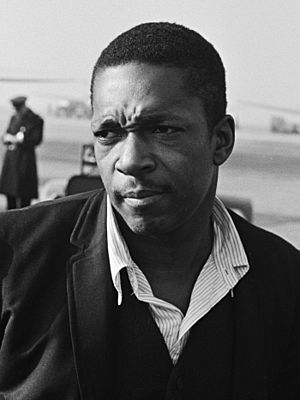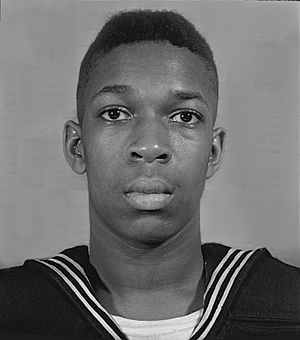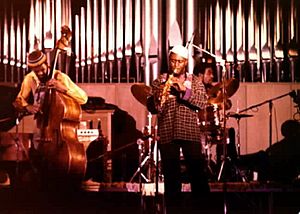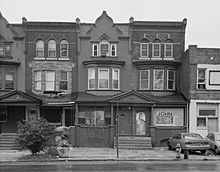John Coltrane facts for kids
Quick facts for kids
John Coltrane
|
|||||||||||
|---|---|---|---|---|---|---|---|---|---|---|---|

Coltrane in 1963
|
|||||||||||
| Background information | |||||||||||
| Birth name | John William Coltrane | ||||||||||
| Born | September 23, 1926 Hamlet, North Carolina, U.S. |
||||||||||
| Died | July 17, 1967 (aged 40) Huntington, New York, U.S. |
||||||||||
| Genres |
|
||||||||||
| Occupation(s) |
|
||||||||||
| Instruments | |||||||||||
| Years active | 1945–1967 | ||||||||||
| Labels |
|
||||||||||
| Associated acts | |||||||||||
| Military career | |||||||||||
| Allegiance | |||||||||||
| Service/ |
|||||||||||
| Years of service | 1945–1946 | ||||||||||
| Rank | |||||||||||
| Unit | Pacific Fleet Ceremonial Band |
||||||||||
| Battles/wars | |||||||||||
| Awards | |||||||||||
|
|||||||||||
John William Coltrane (born September 23, 1926 – died July 17, 1967) was an American jazz musician. He played the saxophone, led his own bands, and wrote music. Many people think he was one of the most important and famous jazz musicians ever. He also influenced 20th-century music.
John Coltrane grew up in North Carolina. After high school, he moved to Philadelphia to study music. Early in his career, he played bebop and hard bop jazz styles. He helped create new ways of playing jazz, like modal jazz and free jazz. Coltrane led many recording sessions and played on albums with other famous musicians. These included trumpeter Miles Davis and pianist Thelonious Monk.
Later in his career, Coltrane's music became more spiritual. His famous album A Love Supreme (1965) shows this. Even decades after his death, Coltrane still inspires musicians. He received many awards after he died, including a special Pulitzer Prize. He was even made a saint by the African Orthodox Church.
His second wife was Alice Coltrane, a pianist and harpist. They had three sons: John Jr., Ravi, and Oran. All three became musicians.
Contents
John Coltrane's Early Life and Music Journey
Growing Up and Finding Music (1926–1945)
John Coltrane was born in Hamlet, North Carolina, on September 23, 1926. His parents were John R. and Alice Blair Coltrane. He grew up in High Point, North Carolina. He went to William Penn High School.
In high school, John played the clarinet and alto horn. By 1940, he switched to the saxophone. He was inspired by musicians like Lester Young and Johnny Hodges. In 1938, he faced sadness when his father, aunt, and grandparents died. His mother and a cousin raised him.
After graduating in 1943, Coltrane and his family moved to Philadelphia. He got a job at a sugar factory. For his 17th birthday, his mother bought him his first alto saxophone. He took saxophone lessons from 1944 to 1945. He also started playing professionally in a small band.
A big moment for Coltrane was seeing Charlie Parker play in 1945. He later said, "the first time I heard Bird play, it hit me right between the eyes."
To avoid being drafted into the Army, Coltrane joined the Navy on August 6, 1945. This was the same day the first U.S. atomic bomb was dropped on Japan. He trained in New York before going to Pearl Harbor in Hawaii. He was stationed at Manana Barracks.
The Navy recognized Coltrane's musical talent. He became a musician in the Melody Masters, the base's swing band. This band was all white, so Coltrane was a "guest" to avoid issues. He also did other duties like kitchen work and security. By the end of his service, he was a leader in the band.
His first recordings were informal sessions in Hawaii on July 13, 1946. He played alto saxophone on jazz songs. He left the Navy on August 8, 1946. He received several medals for his service.
Starting His Career in Jazz (1946–1954)
After the Navy, Coltrane returned to Philadelphia. He joined the exciting new bebop music scene. He used the G.I. Bill to study music theory at the Granoff School of Music. He also took saxophone lessons for a few years.
He toured with King Kolax and then joined Jimmy Heath's band. He started on alto saxophone but switched to tenor saxophone in 1947. This became his main instrument.
Coltrane listened to many musicians like Coleman Hawkins and Ben Webster. He was also influenced by pianist Hasaan Ibn Ali. Coltrane was very dedicated to practicing. His friend Jimmy Heath said he practiced "25 hours a day." He would even fall asleep with his saxophone in his mouth.
Charlie Parker became Coltrane's idol. They sometimes played together in the late 1940s. Coltrane also played in bands led by Dizzy Gillespie, Earl Bostic, and Johnny Hodges.
John Coltrane's Famous Jazz Collaborations
Playing with Miles Davis and Thelonious Monk (1955–1957)
In 1955, trumpeter Miles Davis asked Coltrane to join his new band. This group became known as the "First Great Quintet." It included Red Garland on piano, Paul Chambers on bass, and Philly Joe Jones on drums. Coltrane played with them from 1955 to 1957.
During this time, they made important recordings for Prestige. These albums included Cookin', Relaxin', Workin', and Steamin'. These recordings showed Coltrane's growing talent.
Later in 1957, Coltrane played with pianist Thelonious Monk in New York. They played together for several months. They only made one official studio recording due to contract issues. However, a high-quality recording of a 1957 concert was found. It was released in 2005 as Thelonious Monk Quartet with John Coltrane at Carnegie Hall. This album is highly praised.
Coltrane also recorded Blue Train as a leader for Blue Note Records. Many consider it his best album from this time. It features his own compositions, like "Moment's Notice" and "Lazy Bird".
Developing His Unique Sound (1958)
Coltrane rejoined Miles Davis's band in 1958. By then, it was a sextet. Jazz critic Ira Gitler called Coltrane's new style "sheets of sound." This meant he played many notes very quickly, like a waterfall of sound. Coltrane explained he had to fit notes into "uneven groups like fives and sevens" to play them all.
He stayed with Davis until 1960. During this time, he played on famous albums like Milestones and Kind of Blue. These albums are considered jazz classics.
Solo Work and New Bands (1959–1961)
Coltrane recorded Giant Steps (1960) for Atlantic. This album featured only his own songs. The title track, "Giant Steps," has very complex chord changes. These changes are now known as Coltrane changes. He used these ideas to explore new ways of improvising.
In 1960, Coltrane formed his first quartet for live shows. After some changes, the group settled with McCoy Tyner on piano, Steve Davis on bass, and Elvin Jones on drums. Tyner was a long-time friend.
Their first album was My Favorite Things (1961). This was Coltrane's first album playing the soprano saxophone. This was unusual at the time, as the soprano saxophone was not common in modern jazz.
John Coltrane's Later Music and Spiritual Journey
Joining Impulse! Records (1961–1962)
In 1961, Coltrane signed with Impulse!. This meant he worked again with engineer Rudy Van Gelder. Van Gelder recorded most of Coltrane's Impulse! albums in his New Jersey studio.
By early 1961, Reggie Workman replaced Steve Davis on bass. Eric Dolphy also joined the group, playing a second horn. This quintet played a famous series of concerts at the Village Vanguard. Their music became very experimental. It was influenced by Indian ragas, modal jazz, and free jazz.
Critics had mixed feelings about Coltrane's new style. Some found it too different. In 1961, DownBeat magazine even called Coltrane and Dolphy's music "anti-jazz." But Coltrane wanted every performance to be "a whole expression of one's being."
The Classic Quartet Years (1962–1965)
In 1962, Eric Dolphy left the band. Jimmy Garrison replaced Workman on bass. This group, with Tyner, Garrison, and Jones, became known as the "Classic Quartet." They created deep, spiritual music. Coltrane's playing became more focused on rhythm and melody.
While their live shows were experimental, Coltrane's studio albums were sometimes more traditional. He recorded an album of slow songs called Ballads. He also collaborated with Duke Ellington and singer Johnny Hartman. These albums showed Coltrane's ability to play different styles.
On March 6, 1963, the quartet recorded music that was lost for decades. It was released in 2018 as Both Directions at Once: The Lost Album. The next day, they recorded with Johnny Hartman for their album together.
The Classic Quartet's most famous album was A Love Supreme, recorded in December 1964. This four-part suite was a tribute to his faith. From this point on, Coltrane's music often had spiritual themes. He even wrote a poem for the album's fourth movement, "Psalm," and played one note for each syllable. He composed this album at his home in Dix Hills.
The quartet played A Love Supreme live only three times. Recordings of these concerts have been released.
Exploring Avant-garde Jazz (1965)
Later in his career, Coltrane became interested in avant-garde jazz. This style was played by musicians like Ornette Coleman and Albert Ayler. Coltrane supported many young free jazz musicians, like Archie Shepp. Impulse! Records became a leading label for this new style.
After A Love Supreme, Coltrane's music became more abstract. He used techniques like multiphonics (playing more than one note at once) and playing very high notes. He mostly played the tenor saxophone in the studio. The quartet also played with more freedom.
In June 1965, Coltrane recorded Ascension with ten other musicians. This 38-minute piece featured solos by young avant-garde players. It was controversial because of its group improvisation parts. In September 1965, Coltrane invited Pharoah Sanders to join his band. Sanders used a powerful, "blasting" tone and made unique sounds with his saxophone.
The Second Quartet (1965–1967)
By late 1965, Coltrane often added Sanders and other free jazz musicians to his group. Rashied Ali joined as a second drummer. This marked the end of the "Classic Quartet."
McCoy Tyner left the band because he couldn't hear himself over the two drummers. Elvin Jones also left in early 1966. He was unhappy sharing drumming duties and found Coltrane's new music too complex. Both Tyner and Jones later spoke with great respect for Coltrane. Tyner said, "He was constantly pushing forward... always searching, like a scientist in a lab."
After Tyner and Jones left, Coltrane formed a new quintet. It included Sanders on tenor saxophone, his second wife Alice Coltrane on piano, Garrison on bass, and Ali on drums. This group was known for playing very long versions of their songs, sometimes over an hour.
This group's music can be heard on albums like Live at the Village Vanguard Again! and Live in Japan. In 1967, Coltrane recorded several times. He made albums with the quartet (without Sanders) like Expression and Stellar Regions. He also recorded as a duo with Ali, which became the album Interstellar Space. Coltrane continued to tour until two months before his death. His last recorded performance was a radio broadcast in New York City.
Illness and Passing (1967)
John Coltrane died from liver cancer at age 40 on July 17, 1967. He passed away at Huntington Hospital on Long Island. His funeral was held four days later in New York City. The service featured music from the Albert Ayler Quartet and the Ornette Coleman Quartet. Coltrane is buried at Pinelawn Cemetery in Farmingdale, New York.
Instruments John Coltrane Played
In 1947, John Coltrane switched to the tenor saxophone. This became the instrument he was most famous for. In the early 1960s, he also started playing the soprano saxophone.
He played melodies higher on the tenor saxophone. This might be because he first learned alto horn and clarinet. He said playing the soprano saxophone helped him use the full range of the tenor saxophone. He learned to play "all over" the instrument.
Towards the end of his life, he also experimented with the flute. He played it in live shows and on recordings like Live at the Village Vanguard Again!. After Eric Dolphy died, Dolphy's mother gave Coltrane his flute and bass clarinet.
Drummer Rashied Ali said Coltrane was interested in drums. Coltrane often had a spare drum set on stage and would play it. His interest in drums led to his album Interstellar Space with Ali. Coltrane said he needed "more time, more rhythm all around me." He felt strongly about drums.
Coltrane's tenor and soprano saxophones were sold at auction in 2005. This helped raise money for the John Coltrane Foundation. He also owned a prototype Yamaha alto saxophone. He can be seen playing it on the cover of the album Live in Japan.
John Coltrane's Personal Life and Beliefs
Childhood and Spiritual Roots
John Coltrane grew up in a Christian home. Religion and spirituality were important to him from a young age. Both of his grandfathers were ministers in the African Methodist Episcopal Zion Church. Some critics have noted how Coltrane's music was influenced by his experiences in the southern church.
Family Life
In 1955, Coltrane married Naima (Juanita Grubbs). Naima, who was a Muslim, influenced his spiritual journey. She had a daughter named Syeeda, whom Coltrane adopted. He wrote the beautiful song "Naima" to honor his wife. This was his favorite song he composed.
In 1956, John, Naima, and Syeeda moved to New York City. They later bought a home in Queens. They separated in 1963, but Coltrane remained close with Naima until his death.
In 1963, he met pianist Alice McLeod. They had two sons, John Jr. (born 1964) and Ravi (born 1965). Their third son, Oran, was born in 1967. Alice brought happiness and stability to John's life. They shared many spiritual beliefs, especially an interest in Indian philosophy.
Spiritual Influence in Music
After his album A Love Supreme, many of Coltrane's song and album titles had spiritual meanings. Examples include Ascension, Meditations, and Om. He read books like The Gospel of Sri Ramakrishna and Autobiography of a Yogi. These books explored universal truths and different spiritual paths. Coltrane also studied the Qur'an, the Bible, Kabbalah, and astrology. He explored Hinduism, Jiddu Krishnamurti's teachings, African history, and Zen Buddhism.
In October 1965, Coltrane recorded Om. The title refers to a sacred sound in Hinduism that means the whole universe. The recording includes chants from Hindu and Buddhist texts.
Exploring World Music
Coltrane's spiritual journey was connected to his study of world music. He believed that music had a universal structure. He also thought certain sounds and scales could create specific feelings. Coltrane wanted to understand these musical forces. He hoped his music could bring happiness or even heal people. He once said he wished he could play a song to make it rain or cure a friend.
John Coltrane's Albums
Below are albums that John Coltrane planned and released during his lifetime. It does not include all his recordings with other musicians or albums released after he died.
In 2019, The New York Times Magazine reported that some of John Coltrane's original recordings were destroyed in a 2008 studio fire.
Albums with Prestige and Blue Note Records
- Coltrane (his first solo album; 1957)
- Blue Train (1958)
- John Coltrane with the Red Garland Trio (1958)
- Soultrane (1958)
Albums with Atlantic Records
- Giant Steps (1960)
- Coltrane Jazz (1961)
- My Favorite Things (1961)
- Olé Coltrane (1961)
Albums with Impulse! Records
- Africa/Brass (1961)
- "Live" at the Village Vanguard (1962)
- Coltrane (1962)
- Duke Ellington & John Coltrane (1963)
- Ballads (1963)
- John Coltrane and Johnny Hartman (1963)
- Impressions (1963)
- Live at Birdland (1964)
- Crescent (1964)
- A Love Supreme (1965)
- The John Coltrane Quartet Plays (1965)
- Ascension (1966)
- New Thing at Newport (1966)
- Meditations (1966)
- Live at the Village Vanguard Again! (1966)
- Kulu Sé Mama (1967)
- Expression (1967)
Awards and Recognitions
In 1965, John Coltrane was added to the Down Beat Jazz Hall of Fame. His album A Love Supreme sold over half a million copies in Japan by 1972. It was certified gold in the United States in 2001.
He received a Grammy Award after his death in 1982. This was for Best Jazz Solo Performance on the album Bye Bye Blackbird. In 1997, he received the Grammy Lifetime Achievement Award. In 2002, he was named one of the 100 Greatest African Americans.
In 2007, Coltrane received a special Pulitzer Prize. It recognized his "masterful improvisation, supreme musicianship and iconic centrality to the history of jazz." He was inducted into the North Carolina Music Hall of Fame in 2009.
His former home in Philadelphia, the John Coltrane House, became a National Historic Landmark in 1999. His last home in Dix Hills, New York, was added to the National Register of Historic Places in 2007. His son Ravi, named after Ravi Shankar, is also a saxophonist.
There are also documentaries about John Coltrane. The World According to John Coltrane was made in 1990. Chasing Trane: The John Coltrane Documentary is a 2016 film narrated by Denzel Washington. It tells Coltrane's life story using his own words and interviews with fans like Wynton Marsalis and Bill Clinton.
|
See also
 In Spanish: John Coltrane para niños
In Spanish: John Coltrane para niños





